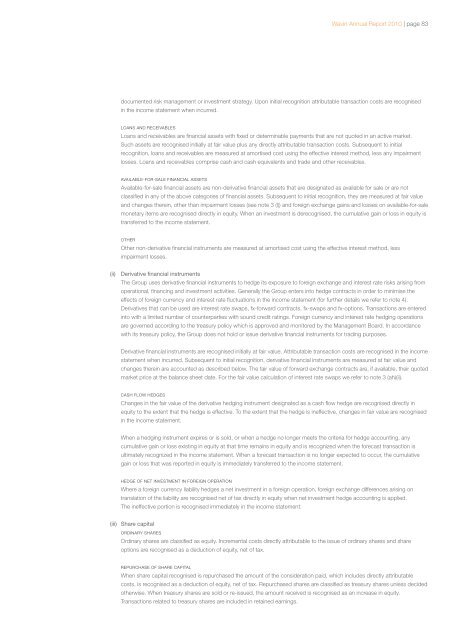Today, Wavin - Jaarverslag.com
Today, Wavin - Jaarverslag.com
Today, Wavin - Jaarverslag.com
Create successful ePaper yourself
Turn your PDF publications into a flip-book with our unique Google optimized e-Paper software.
<strong>Wavin</strong> Annual Report 2010 | page 83documented risk management or investment strategy. Upon initial recognition attributable transaction costs are recognisedin the in<strong>com</strong>e statement when incurred.LOANS AND RECEIVABLESLoans and receivables are fi nancial assets with fi xed or determinable payments that are not quoted in an active market.Such assets are recognised initially at fair value plus any directly attributable transaction costs. Subsequent to initialrecognition, loans and receivables are measured at amortised cost using the effective interest method, less any impairmentlosses. Loans and receivables <strong>com</strong>prise cash and cash equivalents and trade and other receivables.AVAILABLE-FOR-SALE FINANCIAL ASSETSAvailable-for-sale fi nancial assets are non-derivative fi nancial assets that are designated as available for sale or are notclassifi ed in any of the above categories of fi nancial assets. Subsequent to initial recognition, they are measured at fair valueand changes therein, other than impairment losses (see note 3 (l)) and foreign exchange gains and losses on available-for-salemonetary items are recognised directly in equity. When an investment is derecognised, the cumulative gain or loss in equity istransferred to the in<strong>com</strong>e statement.OTHEROther non-derivative fi nancial instruments are measured at amortised cost using the effective interest method, lessimpairment losses.(ii) Derivative financial instrumentsThe Group uses derivative fi nancial instruments to hedge its exposure to foreign exchange and interest rate risks arising fromoperational, fi nancing and investment activities. Generally the Group enters into hedge contracts in order to minimise theeffects of foreign currency and interest rate fl uctuations in the in<strong>com</strong>e statement (for further details we refer to note 4).Derivatives that can be used are interest rate swaps, fx-forward contracts, fx-swaps and fx-options. Transactions are enteredinto with a limited number of counterparties with sound credit ratings. Foreign currency and interest rate hedging operationsare governed according to the treasury policy which is approved and monitored by the Management Board. In accordancewith its treasury policy, the Group does not hold or issue derivative fi nancial instruments for trading purposes.Derivative fi nancial instruments are recognised initially at fair value. Attributable transaction costs are recognised in the in<strong>com</strong>estatement when incurred. Subsequent to initial recognition, derivative fi nancial instruments are measured at fair value andchanges therein are accounted as described below. The fair value of forward exchange contracts are, if available, their quotedmarket price at the balance sheet date. For the fair value calculation of interest rate swaps we refer to note 3 (ah)(ii).CASH FLOW HEDGESChanges in the fair value of the derivative hedging instrument designated as a cash fl ow hedge are recognised directly inequity to the extent that the hedge is effective. To the extent that the hedge is ineffective, changes in fair value are recognisedin the in<strong>com</strong>e statement.When a hedging instrument expires or is sold, or when a hedge no longer meets the criteria for hedge accounting, anycumulative gain or loss existing in equity at that time remains in equity and is recognized when the forecast transaction isultimately recognized in the in<strong>com</strong>e statement. When a forecast transaction is no longer expected to occur, the cumulativegain or loss that was reported in equity is immediately transferred to the in<strong>com</strong>e statement.HEDGE OF NET INVESTMENT IN FOREIGN OPERATIONWhere a foreign currency liability hedges a net investment in a foreign operation, foreign exchange differences arising ontranslation of the liability are recognised net of tax directly in equity when net investment hedge accounting is applied.The ineffective portion is recognised immediately in the in<strong>com</strong>e statement.(iii) Share capitalORDINARY SHARESOrdinary shares are classifi ed as equity. Incremental costs directly attributable to the issue of ordinary shares and shareoptions are recognised as a deduction of equity, net of tax.REPURCHASE OF SHARE CAPITALWhen share capital recognised is repurchased the amount of the consideration paid, which includes directly attributablecosts, is recognised as a deduction of equity, net of tax. Repurchased shares are classifi ed as treasury shares unless decidedotherwise. When treasury shares are sold or re-issued, the amount received is recognised as an increase in equity.Transactions related to treasury shares are included in retained earnings.

















